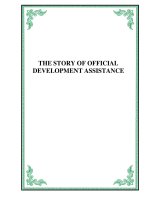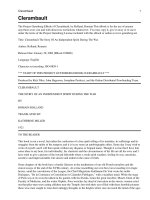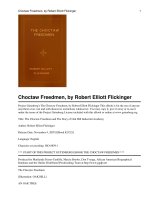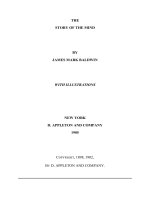5 3 1 the story of flight
Bạn đang xem bản rút gọn của tài liệu. Xem và tải ngay bản đầy đủ của tài liệu tại đây (4.82 MB, 14 trang )
Suggested levels for Guided Reading, DRA,™
Lexile,® and Reading Recovery™ are provided
in the Pearson Scott Foresman Leveling Guide.
Physical Science
The Story
of Flight
by Rena Korb
Genre
Expository
nonfiction
Comprehension
Skills and Strategy
• Author’s Purpose
• Draw Conclusions
• Text Structure
Text Features
•
•
•
•
Table of Contents
Headings
Captions
Glossary
Scott Foresman Reading Street 5.3.1
ISBN 0-328-13533-X
ì<(sk$m)=bdfd c< +^-Ä-U-Ä-U
The Story
of Flight
Reader Response
1. What was the author’s purpose for writing The Story
of Flight? How did you reach this conclusion?
2. The author used time order to structure the book.
Using a graphic organizer such as the one below, make
a time line showing major dates in the history of flight.
by Rena Korb
Major Dates in the History of Flight
first manned
balloon flight
1783
3. Make a word web with the word flight in the center.
Around it, write words from the book that relate to
flight.
4. What improvements would you make if you were to
design future aircraft? Why would you make such
improvements?
Editorial Offices: Glenview, Illinois • Parsippany, New Jersey • New York, New York
Sales Offices: Needham, Massachusetts • Duluth, Georgia • Glenview, Illinois
Coppell, Texas • Ontario, California • Mesa, Arizona
CONTENTS
CHAPTER 1
4
Early Dreams and Attempts
CHAPTER 2
8
The Wright Brothers
CHAPTER 3
11
Early Airplanes and War
CHAPTER 4
14
The Many Uses of Airplanes
CHAPTER 5
Every effort has been made to secure permission and provide appropriate credit for
photographic material. The publisher deeply regrets any omission and pledges to
correct errors called to its attention in subsequent editions.
Unless otherwise acknowledged, all photographs are the property of Scott Foresman,
a division of Pearson Education.
Photo locators denoted as follows: Top (T), Center (C), Bottom (B), Left (L), Right (R),
Background (Bkgd)
19
More Warplanes
CHAPTER 6
21
Speedy Airplanes
Glossary
24
Opener: Library of Congress; 1 Corbis; 4 (BL) Library of Congress, (B) Corbis; 5 Bridgeman
Art Library; 6 Corbis; 7 Corbis; 9 Library of Congress; 10 Bettmann/Corbis; 11 Library of
Congress; 12 Corbis; 13 Getty Images; 14 Getty Images; 15 (Bkgd) Bettmann/Corbis, (C)
Corbis; 16 Corbis; 18 The Goodyear Tire and Rubber Company; 19 National Archives;
21 Neville Dawson/Photo Library; 22 DK Images; 23 DK Images
ISBN: 0-328-13533-X
Copyright © Pearson Education, Inc.
All Rights Reserved. Printed in the United States of America. This publication is
protected by Copyright, and permission should be obtained from the publisher
prior to any prohibited reproduction, storage in a retrieval system, or transmission
in any form by any means, electronic, mechanical, photocopying, recording, or
likewise. For information regarding permission(s), write to: Permissions Department,
Scott Foresman, 1900 East Lake Avenue, Glenview, Illinois 60025.
2 3 4 5 6 7 8 9 10 V0G1 14 13 12 11 10 09 08 07 06 05
3
Chapter 1 Early Dreams and Attempts
Since the dawn of time, people have dreamed of flying.
An ancient Greek myth describes a man who flew through
the air on wings made of feathers and candle wax. The
ancient Chinese may have attempted to fly using the kites
they invented. And during the Middle Ages, people jumped
off towers with “wings” made of cloth in unsuccessful
attempts to fly!
Despite such early failures, people refused to give up
on the idea of human flight. Leonardo da Vinci was one
person who did not hesitate in his belief that humans could
fly. The great fifteenth-century artist and inventor, after
spending hours studying birds in flight, filled his notebooks
with sketches of flying machines such as the ornithopter.
The pilot was to steer it by moving his head and neck, and
power it by flapping its large mechanical wings.
Sadly, da Vinci never built his ornithopter, and over the
next few hundred years, little progress was made on flying
machines.
A painting showing the
launch of the Montgolfiers’
hot-air balloon.
Da Vinci filled his notebooks
with designs for all kinds of
flying machines.
Two brothers, Joseph-Michel and Jacques-Etienne
Montgolfier, owned a paper factory in France in the late
eighteenth century. One day, while experimenting in their
factory, they realized that a paper bag rose as it filled with
hot air and descended as the air cooled. This discovery
inspired the brothers to build a large cloth balloon with a
basket underneath. A fire inside the basket heated the air,
causing the balloon to rise.
4
5
On November 21, 1783, in the presence of King Louis
XVI, Queen Marie Antoinette, Benjamin Franklin, and
many a loyal French subject, two men took to the air in a
Montgolfier balloon. The flight lasted twenty-five minutes,
during which time the balloon traveled five miles and rose
three thousand feet into the air. At last, people could fly!
By the end of the 1800s, people were traveling long
distances in balloons. Photographers took pictures from
balloons, joyriders rode them for pleasure, and armies used
them to spy on their enemies.
At the same time, inventors were developing new
types of flying machines. In contrast with balloons, these
machines were “heavier than air,” meaning that they did not
use hot air or other gases to keep them aloft.
One of those inventors was an Englishman named Sir
George Cayley. Cayley earned the nickname “Father of
Aeronautics” for his studies of the motion of air. He spent
much of his life designing gliders. These machines looked
similar to modern planes, with wings in front and a tail in the
back. In 1853, Cayley tested one of his gliders by sending his
chauffeur into the air. Upon landing, the driver quit!
A German named Otto Lilienthal, who was inspired
by Cayley’s work, designed and built a series of gliders
during the 1890s. Lilienthal’s gliders looked very similar to
the hang gliders of today. Lilienthal tested out his designs
by going to the top of a hill, strapping on his cloth-covered
wooden wings, and jumping! In this way, Lilienthal “flew”
as far as one thousand feet.
Otto Lilienthal, who influenced
the Wright brothers, steered his
gliders by swinging his legs and
shifting his weight.
6
7
Chapter 2 The Wright Brothers
Europeans were not the only people inventing flying
machines. In the United States, Orville and Wilbur Wright
also set their sights on taking to the skies. The Wright
brothers had been interested in flying since they were young.
As adults, they owned a bicycle shop. Building and repairing
bicycles helped them learn how to design machines.
By the late 1890s, after having studied gliders and
aeronautics, the Wright brothers started work on an
airplane. They designed and tested wings, propellers, and
ways to control the aircraft. Not all of their tests worked.
But they learned something from everything they tried,
ensuring that none of their experiments were worthless.
By late 1903, the Wright brothers’ airplane, which they
named the Flyer, was ready. Powered by a small gasoline
engine, the Flyer had two sets of wings and propellers, and
two movable rudders. These devices worked together to
permit the pilot to control the plane.
On December 17, 1903, at Kitty Hawk, North Carolina,
Orville lay on the Flyer’s lower wing while Wilbur pushed
the plane along a track. Wilbur watched as the Flyer rose
into the air. Twelve seconds and 120 feet later, Orville set
the plane down safely. The Wrights had just completed the
world’s first controlled airplane flight!
8
Orville’s brother,
Wilbur, gave the Flyer
the push it needed to
take to the skies.
Orville Wright flew into
history on December
17, 1903, by piloting
the Flyer.
9
Chapter 3 Early Airplanes and War
Several months after the Wright brothers demonstrated
their airplane, Glenn Curtiss won a trophy for making
the first successful airplane flight in front of the public.
(Remember that the Wright brothers had conducted their
flights in secret.) Curtiss’s one-mile flight in the June Bug
appeared on the cover of newspapers and in newsreels.
During that time, airplanes also made big news in Europe,
where pilots competed for flying “firsts.”
Glenn Curtiss and the Wright brothers
were rivals. This photo shows Curtiss’s
airplane, the June Bug.
The Wright brothers continued to improve their
airplane. Over the next few years, they flew hundreds of
trips. Some lasted for more than twenty miles. Afraid that
a scoundrel would steal their ideas, the Wrights made
their flights in secret. Finally, in 1908, they demonstrated
their airplane to the U.S. Army. By then, other inventors
in the United States and Europe were trying their hands at
building their own airplanes.
10
11
Following the achievements of Curtiss and the Wright
brothers, airplanes began to change American society. Some
people started going to air shows to see airplane stunt pilots
perform exciting and entertaining feats. Others thought
about designing airplanes that the public could travel in.
The age of aviation had begun.
Then, in 1914, World War I began. Airplane designers
scrambled to design warplanes for the warring countries.
Both the Allied Powers (consisting of England, France,
Russia, Italy, and the United States) and the Central Powers
(made up of Germany, Austria-Hungary, and Turkey) used
planes to spy on enemy territory and gain information about
troops and weapons. Military leaders used their countries’
air forces to help plan attacks.
World War I military leaders also started using airplanes,
such as bombers, against their enemies. The first bombers
were small and could only carry grenades and other light
bombs. Soon, however, both sides were building bigger
planes that carried larger loads of bombs. But bombers had
a fierce foe in the sky: fighter planes.
12
The first fighter planes were simple military planes
loaded with large guns. The pilot fired the guns from within
the cockpit. Airplane designers soon improved the designs
of fighter planes, building aircraft that carried machine guns
mounted in front of the pilot. A special gear allowed the
guns to fire in between the planes’ spinning propeller blades.
Thousands of feet in the air, enemy planes battled in
“dogfights.” They circled, chased, and dodged each other.
To gain the upper hand, they swooped down on or snuck
up behind the enemy. Some pilots were able to shoot down
five or more planes. One German ace, known as the “Red
Baron” because of his red plane, shot down eighty Allied
planes before he was shot down himself in 1918.
The British Sopwith Camel was
one of the legendary fighter
planes of World War I.
13
Chapter 4 The Many Uses of Airplanes
World War I ended in 1918. In the years that followed,
the improvements made to airplane designs during the war
were applied to peacetime aircraft. Aviation became even
more popular.
With the war over, there was a reduced need for
pilots, but many wanted to keep flying. The United States
military helped these pilots by selling warplanes, minus
their weapons, for low prices. Many pilots bought their
own planes and traveled from town to town putting on air
shows. Called “barnstormers,” these daring fliers performed
breathtaking stunts such as dips, loops, and rolls.
The stunning feats of the barnstormers fascinated
Americans. When the barnstormers weren’t putting on
flying shows, they competed in air races for world records,
personal glory, and cash prizes.
Of all those pilots, people looked most admiringly
upon Charles Lindbergh. He was known as “Lucky Lindy”
because he survived several airplane crashes. Lindbergh
wanted to be the first person to fly solo across the Atlantic
Ocean. He began by taking off from New York City on May
20, 1927, in his famous plane, the Spirit of St. Louis.
Lindbergh battled storms, fog, cold, and sleepiness
during his flight. A little more than thirty-three hours later,
he landed in Paris and was greeted by cheering crowds.
Overnight, Lindbergh became an international hero.
Amelia Earhart earned the nickname “Lady Lindy” for
being the first woman to fly across the Atlantic Ocean. She
showed the world that women could fly planes too.
Amelia Earhart was
a pioneer among
female pilots.
Barnstormers thrilled the
American public in the years
following World War I by putting
on incredible flying displays.
14
15
People also realized that airplanes could be used for
more than barnstorming shows and record-setting flight
attempts. On May 15, 1918, a full six months before the
end of World War I, pilots hired by the U.S. Postal Service
began flying mail between New York City and Washington,
D.C. Demand was so great that within months the post
office expanded service to include the entire country.
The DC-3 began carrying regular
passengers in 1936. About one
thousand DC-3s still fly today.
In the mid-1920s, the U.S. Postal Service began hiring
private companies to fly the mail. To earn extra money,
these companies sometimes sold tickets to passengers,
thereby becoming some of the earliest passenger airlines.
Early passengers put up with a lot to experience the thrill of
flying. They were forced to sit on mailbags and often had to
get off the planes to make more space for mail!
Although passenger airlines began during the mid1920s, the first passenger flight took place a decade earlier
in 1914, when a plane flew tourists between Tampa and St.
Petersburg in Florida. Still, air travel didn’t become popular
in the United States until the 1930s. During that decade,
airplanes improved dramatically. The newest planes traveled
longer distances, carried more passengers, and flew at night.
Because of these changes, airplanes could deliver
passengers in safety throughout the country and across
Europe. The airlines also made air travel enjoyable. When
passengers climbed aboard, flight attendants showed them
to comfortable seats and served them food and drinks.
Airmail cut the time taken
to deliver mail by almost
seventy hours!
16
17
Chapter 5 More Warplanes
By 1939, when World War II broke out, warplanes had
advanced. The German air force, known as the Luftwaffe, or
“air weapon,” launched speedy attacks known as blitzkriegs,
or “lightning wars,” that helped Germany conquer most
of Europe. As the war progressed, German and Japanese
warplanes bombed many areas in Europe and Asia.
German dirigibles were called
zeppelins in honor of their inventor
Count von Zeppelin. The Hindenburg
zeppelin, shown here flying over
New York City, was the most famous.
While these changes were occurring, inventors were
also experimenting with other types of flying machines. By
the 1920s, designers had developed the airship. Also called
blimps or dirigibles, airships were long, gas-filled balloons
that had covered cabins for their passengers and crews.
Huge German airships traveled across the Atlantic during
the 1920s and 1930s. Passenger airship travel ended in 1937,
however, when the Hindenburg exploded as it tried to land at
a docking station in Lakehurst, New Jersey.
Flying boats were also popular in the 1930s. They had
regular wings, but their bodies were shaped like the hull of a
ship. They landed and took off at sea. As passenger airplanes
and airports improved, airlines stopped using flying boats.
Igor Sikorsky built the first successful helicopter during
the 1930s. Helicopters could fly sideways, backwards, and
straight up or down, making them very popular.
18
During World War II Luftwaffe
warplanes conducted bombing raids on
major European cities such as London,
Rotterdam, Warsaw, and Belgrade.
19
To fight back, Great Britain and the United States
built thousands of new fighter planes and bombers. These
new warplanes were very different from the ones flown
during World War I. Planes now had radios so pilots could
coordinate their attacks and warn each other of approaching
enemy planes. Another key development was radar. Radar
operators told pilots the locations of enemy planes.
Much of World War II took place over the Pacific
Ocean. To support planes in the Pacific, huge ships called
aircraft carriers were built. Also known as “flattops,” they
stretched more than eight hundred feet long and could carry
one hundred aircraft. Planes landed, refueled, and took off
from the decks of these floating airfields.
Military planes helped England, the Soviet Union, and
the United States defeat Germany and Japan. Bomber
attacks deep within Germany caused serious damage to
German industry. When two U.S. B-29 bombers dropped
atomic bombs on Japan in August 1945, the War in the
Pacific ended. Airplanes played a key role throughout the
war.
Chapter 6 Speedy Airplanes
In the years after World War II, air travel became more
common. Because of the war, many countries had new
airports, more large planes, and more skilled pilots. Planes
could travel faster and fly long distances more easily. The
development of the jet engine at the end of World War II
marked a major advance in airplane technology. Jet engines
enabled planes to fly much faster than ever before.
The underside of a Boeing 747. Each 747
engine is more powerful than all four
engines on a Boeing 707 combined!
20
21
Jet engines also had a huge effect on air travel. In 1958,
the new Boeing 707 carried passengers nonstop across
the Atlantic Ocean from New York City to Paris. This jet
airliner was remarkable for its speed and size. It had room
for up to 181 passengers and could travel 600 miles per
hour. That year, more than one million people flew between
the United States and Europe. For the first time in history,
more people crossed the Atlantic by plane than by ship.
In the 1970s, British and French airplane designers
came up with the Concorde, a supersonic (faster than the
speed of sound) passenger jet. From 1977 through 2003, the
Concorde flew passengers every day at speeds approaching
1,400 miles per hour, cutting the flying time from the United
States to Europe in half!
The Airbus A380 is one of the newer passenger jets.
This massive plane can carry up to 840 passengers. The
plane has enough space to include bedrooms, bars, gyms,
and lounges!
It’s hard to believe that the first airplane flight took
place only a little more than one hundred years ago. Since
then, planes have changed greatly. And they’ve changed the
world in which we live. Airplanes do a lot more than carry
passengers and fight in wars. Planes help water crops, fight
fires, monitor weather, and also make for an enjoyable hobby.
Who can say what the future of flight holds? Perhaps
someday, everyone will be able to strap on wings and
fly through the air, just as da Vinci dreamed. Or maybe
one day, most homes will have an airplane parked in the
garage next to the family car! One thing is certain: as long
as people gaze at the sky and dream about flying, we will
continue to design new and exciting flying machines.
In only one hundred years,
airplanes have developed from
the Wright brothers’ tiny and
basic Flyer into the massive and
advanced jet airliners of today.
The Boeing 747 (shown in both
images) is also known as the
“jumbo jet.”
22
23
Glossary
admiringly adv. with
respect and awe.
permit v. to make possible
or allow.
scoundrel n. a dishonest
person.
Reader Response
subject n. a person who
lives under the rule of a
king or queen.
worthless adj. having no
value or use.
1. What was the author’s purpose for writing The Story
of Flight? How did you reach this conclusion?
2. The author used time order to structure the book.
Using a graphic organizer such as the one below, make
a time line showing major dates in the history of flight.
Major Dates in the History of Flight
first manned
balloon flight
1783
3. Make a word web with the word flight in the center.
Around it, write words from the book that relate to
flight.
4. What improvements would you make if you were to
design future aircraft? Why would you make such
improvements?
24









